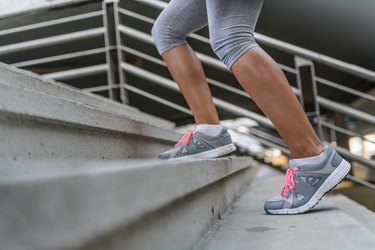
While muscles are what move your joints, it's the nerves that provide them with power. Prolonged pressure or nerve damage in your knee or other parts of the lower body can lead to leg weakness. Strengthening exercises can help.
Read more: 10-Minute Leg-Sculpting Workout
Video of the Day
Video of the Day
Understanding Nerve Injury
Leg weakness can develop after nerve damage in your knee, hip, ankle or even in your lower back. Nerve issues can develop as a result of arthritis, poor posture, direct trauma, diabetes or kidney disease, or as a side effect of medications, according to the U.S. National Library of Medicine.
Once the nerve has healed or the underlying cause of the damage is removed, your strength will likely improve with exercise. For example, in a September 2012 article published by Oncology Nursing Forum, strengthening exercises were shown to improve leg strength and balance for individuals with chemotherapy-induced nerve damage.
For an individualized exercise program, consult a physical therapist. Strengthening exercises are often performed in sets of 10 repetitions, working up to three sets in a row. Hold each position for two to three seconds, and lower down slowly.
1. Hip Exercises
Move 1: Straight Leg Raise
- Lie on your back on a firm surface.
- Bend one knee and place your foot on the floor.
- Keeping the other leg straight, raise your leg straight up toward the ceiling, as high as you comfortably can.
Move 2: Side Leg Raise
- Lie on your unaffected side with your legs stacked on top of each other.
- Keeping your knee straight, lift your top leg up toward the ceiling. Be sure to keep your toe pointed forward.
- Slowly lower it back down.
Move 3: Hip Extension
- Lie face-down, with your forehead supported for comfort.
- Keeping your leg straight, squeeze your buttocks muscle and lift your leg up off the ground.
- Slowly lower it back down.
2. Knee Exercises
Move 1: Hamstring Curls
- Stand next to a supportive surface for balance.
- Bend one knee, bringing your heel up toward your buttock.
- Slowly lower it back down.
Move 2: Knee Extensions
- Sit on a firm surface with your feet on the floor.
- Straighten your knee, without leaning backward.
- Slowly lower your leg back down.
Read more: How to Do Leg Workouts at Home
3. Ankle Exercises
Move 1: Toe Raises
- Sit up straight with your feet on the floor.
- Keeping your heel planted on the ground, lift the front of your foot as high as possible.
Move 2: Calf Raises
- Sit up straight with your feet on the ground.
- Keeping the ball of your foot planted on the ground, lift your heel as high as possible.
As strength improves, try calf raises in a standing position, as demonstrated by the American Academy of Orthopaedic Surgeons.
Add Some Compound Exercises
Compound exercises, as demonstrated by the Australian College of Sport and Fitness, target muscles throughout your leg in one movement. Squats are a commonly performed compound exercise.
Start out by holding onto a stable surface to assist with your balance. As strength improves, add resistance, such as dumbbells, to this movement.
- Stand with your feet wider than hip width apart.
- Reach your arms out in front of you at shoulder height.
- Pushing your knees apart, sit your hips back as if you are going to sit on a chair.
- Slowly bend your knees until your thighs are parallel to the floor.
- Return to a standing position.
- U.S. National Library of Medicine: "Peripheral Neuropathy"
- Oncology Nursing Forum: "Strength and Balance Training for Adults with Peripheral Neuropathy and High Risk of Fall: Current Evidence and Implications for Future Research"
- American Academy of Orthopaedic Surgeons: "Foot and Ankle Conditioning Program"
- Australian College of Sport & Fitness: "Top 35 Lower Body Exercises"
Is this an emergency? If you are experiencing serious medical symptoms, please see the National Library of Medicine’s list of signs you need emergency medical attention or call 911.